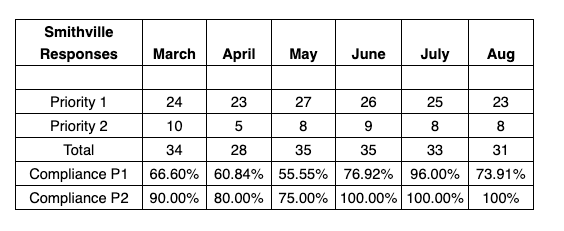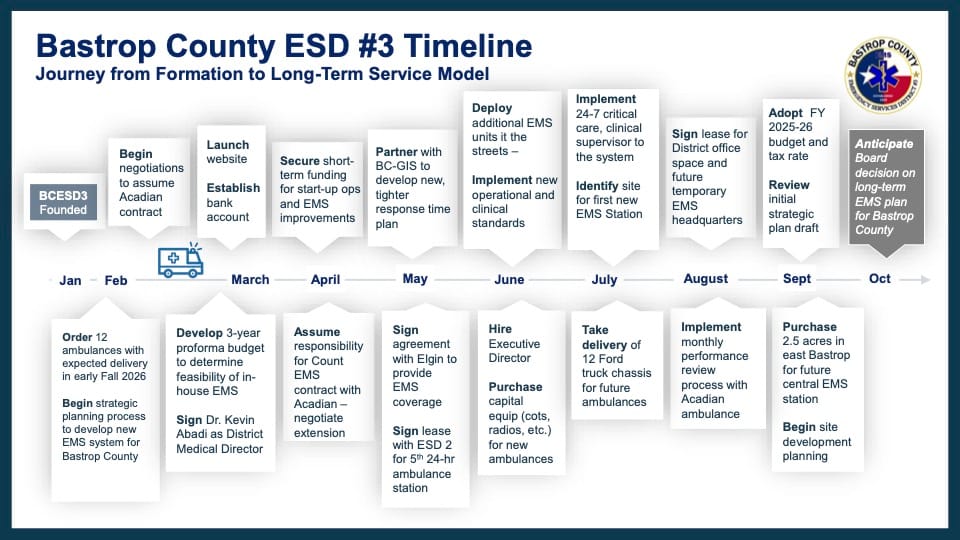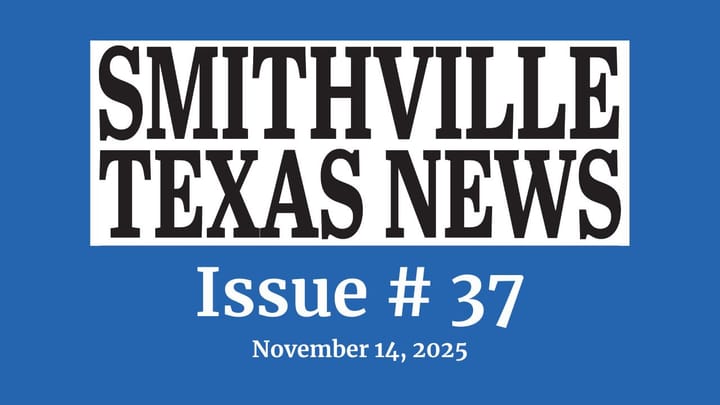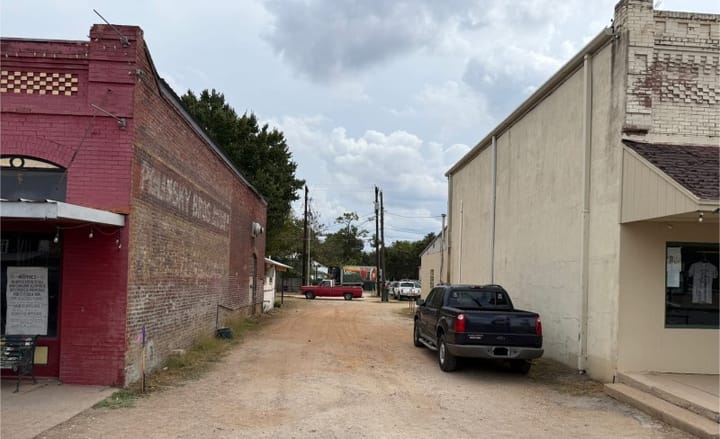ESD No. 3 Boosts Ambulance Service, Cutting Wait Times for Smithville Residents
Smithville residents are seeing shorter wait times for ambulances after more units were added to service Bastrop County this summer.

By Kristen Meriwether, Publisher
Smithville residents are seeing shorter wait times for ambulances after more units were added to service Bastrop County this summer. The increased capacity was part of Bastrop County Emergency Services District No. 3’s contract negotiations with Acadian Ambulance to address strained emergency medical services across the county.
ESD No. 3 was approved by voters last November to fund and expand EMS service through property taxes, with the initial rate of 10 cents per $100 valuation.
For now Acadian will continue to provide the ambulances and medics to aid Bastrop County residents and guests. But with funding now in place, EMS service is not only expanding, but ESD No. 3 is monitoring response times and outcomes in one of the most unique ambulance contracts in Acadian’s portfolio.
The new contract, which started June 1, added one additional 24-hour ambulance and two additional 12-hour ambulances during peak times. The additional units have increased response times around the county, but especially here in Smithville.
Before June, the ambulance located in Smithville was often the first to be relocated when any ambulance in the county received a call. But with more ambulances on the road, the Smithville unit is staying home more often.
“That ambulance is not moving as much now because the ESD commissioners have elected to have a fifth, 24-hour ambulance that's always on,” Rusty Wood, director of operations, Texas Division, for Acadian Ambulance Service, said in an interview last week. “Your ambulance is there about 90% of the time now.”
In June, the first month with the additional ambulances, response times in Smithville for a priority one call (highest urgency) increased from 55% to as high as 96%. Priority two calls have been 100% compliant.

With more coverage, medics are able to do more than just reach patients quickly. Barton Brannon, a clinical field supervisor for Acadian, recalled responding to a recent structure fire. After they had helped the resident, firefighters pulled out two dogs, and Brannon and another first responder were able to provide oxygen to the animals.
After a few minutes, the dogs perked up, began wagging their tails, and ultimately survived the fire.
“We're in this job to try to make a difference, and here were two animals, two living creatures, that needed help. So we helped them,” Brannon said in a phone interview. “It wasn't taking us away from helping a person, so I figured, hey, if we could make a difference, then let's see what we can do and try to help.”
Expanding Coverage Area
When the ESD No. 3 commissioners were looking at how to set the response time windows, they chose not to stop at city limits.
“We felt like our goal would be, how do we better understand where our population densities are, where the major call volumes are happening, and see what we can do to establish a kind of a system status that would utilize units in the best priority,” Bastrop County ESD No. 3 Commissioner Loren Stagner said in an interview last week.
Instead of using geographic lines, the commissioners redesigned the entire system using population density.
“No other contract that I'm responsible for or that I'm aware of goes this deep into population density,” Wood said. “This particular ESD board is very forward thinking in the fact that they want to make sure that they are getting the biggest population covered with the best EMS service capable, in the fastest response time.”
Priority two calls in some areas of Bastrop County were allowed up to 20 minutes of response time. But with the new contract, not a single area of the county allows more than 20 minutes.
“All of the county requires a much tighter response compliance,” Wood said. “It has been a challenge, but they did add some resources, and all of the citizens and guests of Bastrop County are benefiting from it.”

Measuring Outcomes
While response times are one important way to measure success, the commissioners wanted to also track and measure patient outcomes.
“One of the things I've learned over the years of managing EMS systems is that getting there quickly is just a piece of the whole equation,” ESD No. 3 Executive Director Ernie Rodriguez said. “You have to follow it up with excellent patient care. And if you don't put those two things together, then you don't have better survival rates.”
One thing Acadian has opted to do to increase patient outcomes that is not required in the contract is carry blood products in two units, as well as the clinical supervisor’s vehicle. Wood said there is not a single other thing proven to improve patient outcomes better than giving blood in the field prior to hospital arrival.
Acadian also has a 24-hour clinical supervisor to measure the quality of care every patient receives. Each medical record that is created is audited for quality and accuracy, and then feedback is provided. Reports will also be provided to the public.
“I personally believe we've provided amazing care over the last decade to the citizens and guests of Bastrop County,” Wood said. “But now we are actually measuring that.”
The commissioners also negotiated a contract with PHI for air ambulance service for every resident of Bastrop County. Both Bastrop and Smithville had their own contracts with PHI, but the cities were able to recoup that money and use the county-wide contract through ESD No. 3. For Smithville, it was a savings of $13,000.
Many of these ideas and savings would not have been possible without the commissioners’ decades of experience in emergency medical services.
“The experience level that they bring to this board is just outstanding,” Wood said. “Bastrop County is probably one of the luckiest counties that I'm aware of.”




Comments ()